Lake Erie 1813
Battle of Lake Erie — Battle of the Thames
Throughout 1812 and into 1813, a British squadron led by Commander Robert H. Barclay held control of Lake Erie. Control of the Great Lakes was of paramount importance in the War of 1812. Roads were rough or nonexistent, especially in the Old Northwest, so moving and supplying troops was most efficiently accomplished by boat. Starting in the fall of 1812, the United States began construction of a squadron of ships on Presque Isle in Lake Erie under U.S. Master Commandant Oliver H. Perry, completing the work in July 1813. Perry used his squadron to block supplies headed to the British Fort Amherstburg, and the British squadron under Barclay sailed out to meet to confront Perry.
On September 10, 1813, the two squadrons met and exchanged fire for nearly three hours, leaving Barclay seriously wounded and many senior British officers dead. Perry began the battle on his flagship, the Lawrence, but after hours of battle it was severely disabled. Perry was rowed out to the Niagara, a ship that had been hanging back from the main fighting, and resumed the battle from there. The British squadron surrendered not long afterward. Perry was widely celebrated for his victory, the first U.S. defeat of an entire squadron, and the victory secured control of the Lake Erie, strengthening the position of Harrison’s army in the west.
After the rout of the British squadron on Lake Erie, Brigadier General Henry Procter retreated from Fort Amherstburg on the Detroit River and moved northeast with a small force of British regulars and native Americans toward the British stronghold of York. On the way, he encountered United States forces under General Harrison. Colonel RM Johnson led the cavalry charge of Kentucky militia on Procter’s position, devastating Procter’s forces and killing the Native leader Tecumseh. The Battle of the Thames (also known as the Battle of Moraviatown) secured U.S. control of the Northwest and delivered a terminal blow to the Pan-Indian movement. It also made the careers of a number of U.S. military men, including a future president, vice president, four senators and twenty congressmen.
Related Items

Plan of Attack
Order of sailing... September 1813.
Written on board Perry’s flagship, the Lawrence, this document lists the ships in the American fleet and matches them up to those of their British opponents. One of the ships was too new for the Americans to know its name and so it is listed as “new ship”. This vessel was the British sloop Detroit which succeeded in destroying its opponent, the Lawrence.
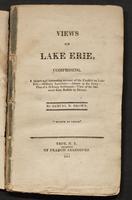
Views on Lake Erie
Samuel R. Brown. Views on Lake Erie, comprising a minute and interesting account of the conflict on Lake Erie - military anecdotes - abuses in the army - plan of a military settlement - view of the lake coast from Buffalo to Detroit. Troy, N.Y., Printed by Francis Adancourt, 1814.
Perry’s flagship, the Lawrence, was named after Captain James Lawrence who was killed in the action between his ship Chesapeake and the British Shannon. Written by a New York state newspaper editor, this book includes a detailed account of the Battle of Lake Erie, also called the Battle of Put-in-Bay, including a dramatic account of the moments leading up to the conflict in which “Perry caused an elegant flag, which he had privately prepared, to be hoisted at the mast-head of the Lawrence: on this flag was painted in characters, legible to the whole fleet, the dying words of the immortal LAWRENCE: -- “Don’t give up the ship.” Its effect is not to be described—every heart was electrified” (page 5, image 9).
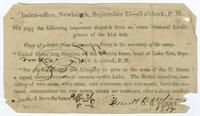
Perry's famous dispatch
Copy of a letter from Commodore Perry to the Secretary of the navy. Newburgh, NY : Index-office, 1813.
A small newspaper broadside reproducing Perry’s famous dispatch about the capture of British squadron.
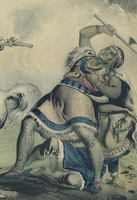
Images of the Battle of the Thames
Colonel Johnson Shoots Tecumseh. 1846
This print, published long after the battle, depicts a dynamic scene in which Colonel Robert Johnson kills the Pan-Indian leader Tecumseh.
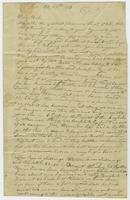
News of the Battle of the Thames
Letter from Garrit Bras to Nathaniel E. Mattews. Ocotober 29, 1813.
Garrit Bras, a resident of Mentor, Ohio, wrote to a friend in Massachusetts: “Gen. Harrison has had a battle with the indians & conquered. It is said that Tecumsie the Indian general Brother to the Prophet was killed in the battle.”
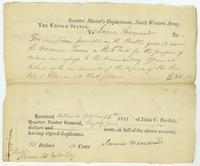
A Receipt from the Battle of the Thames
U. S. Army Quartermaster’s Department to James Harwood. October 15, 1813.
The more pedestrian details of war are closely connected to the big events. In this receipt, James Harwood acknowledged the receipt of eighty-five dollars “for one horse furnished on the Battleground near the Moravian Towns on the 5th Inst. for the purpose of sending an express to the Commanding Officer at Detroit with an account of the defeat of the British and Indians at that place." On the reverse, General Harrison approved the expense.



